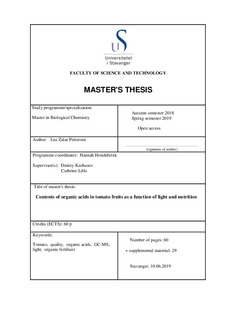| dc.contributor.advisor | Kechasov, Dmitry | |
| dc.contributor.author | Pettersen, Lea Zalar | |
| dc.date.accessioned | 2020-02-26T10:36:25Z | |
| dc.date.available | 2020-02-26T10:36:25Z | |
| dc.date.issued | 2019-06-10 | |
| dc.identifier.uri | http://hdl.handle.net/11250/2643871 | |
| dc.description | Master's thesis in Biological chemistry | nb_NO |
| dc.description.abstract | Tomato (Solanum lycopersicum) is one of the most consumed vegetables in the world. It is a source of antioxidants, minerals and vitamins, and has many beneficial effects on health.
In the last decades, the taste properties of commercially produced tomatoes have declined as a consequence of breeding for high yield, harvesting at the green immature stage and improper post-harvesting practices. Several recent studies therefore focus on gaining information how to reattain high quality in terms of organoleptic properties. A challenge in norwegian tomato production is lack of light, even in the summer months. To solve this problem producers utilize supplementary lighting to provide enough irradiation for the tomato plants. Another aspect that is becoming important in food production is environmental pollution. The conventional hydroponic system has the disadvantages of using high amounts of water and releasing unused mineral fertilizers into the environment. The organoponic system is a new approach where organic fertilizer is used and recirculated, which allows for a sustainable production of fresh vegetables.
It is well known that taste of tomato fruits is affected by a combination of organic acids, sugars and volatile compounds. In this study, the content of organic acids and quality of tomatoes as a function of different lighting and nutrients were investigated. The effect of organic fertilizer and growth promoting bacteria on content of organic acids and quality was compared to standard mineral nutrient solution. In addition, the influence of supplementary inter-row and top light intensities on the quality and content of organic acids in tomato fruits was examined.
The results showed that quality of tomatoes is affected by both light and nutrients. LED inter-row lighting had a positive effect on the quality of tomatoes at lower top light (HPS lamps) intensities. Tomatoes grown in standard mineral nutrient solution had higher quality (higher TTA and SSC) than tomatoes grown with organic fertilizer. However, tomatoes grown with organic fertilizer had the highest levels of vitamin C. The organoponic system is a new promising approach with potential for improvements. It is environmentally friendly method that deserves further attention and research. | nb_NO |
| dc.language.iso | eng | nb_NO |
| dc.publisher | University of Stavanger, Norway | nb_NO |
| dc.relation.ispartofseries | Masteroppgave/UIS-TN-IKBM/2019; | |
| dc.subject | GC-MS | nb_NO |
| dc.subject | biologisk kjemi | nb_NO |
| dc.subject | tomato | nb_NO |
| dc.subject | quality | nb_NO |
| dc.subject | organic acids | nb_NO |
| dc.subject | light | nb_NO |
| dc.subject | organic fertilizer | nb_NO |
| dc.subject | økologisk gjødsel | nb_NO |
| dc.subject | tomater | nb_NO |
| dc.title | Contents of organic acids in tomato fruits as a function of light and nutrition | nb_NO |
| dc.type | Master thesis | nb_NO |
| dc.subject.nsi | VDP::Mathematics and natural science: 400::Basic biosciences: 470::Biochemistry: 476 | nb_NO |
